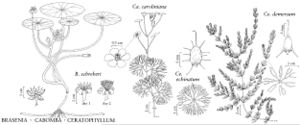Ceratophyllum demersum
Sp. Pl. 2: 992. 1753.
Stems to 3 m; apical leaf whorls densely crowded. Leaves bright green, coarse-textured. Leaf blade simple or forked into 2-4(-5) ultimate segments (forking of largest leaves 1st or 2d order, rarely 3d order), segments not inflated, mature leaf whorls 1.5-6 cm diam., marginal denticles conspicuous, usually strongly raised on broad base of green tissue; 1st leaves of plumule simple. Achene dark green or reddish brown, body (excluding spines) 3.5-6 × 2-4 × 1-2.5 mm, basal spines or tubercles 2 (rarely absent), straight or curved, 0.1-12 mm, spine bases occasionally inconspicuously webbed, marginal spines absent, terminal spine straight, 0.5-14 mm, margins wingless. 2n = 24, 38, 40, 48.
Phenology: Flowering spring–late fall.
Habitat: Fresh to slightly brackish rivers, streams, ditches, lakes, ponds, pools, marshes, swamps
Elevation: 0-1700 m
Distribution

Alta., B.C., Man., N.B., N.W.T., N.S., Ont., P.E.I., Que., Sask., Yukon, Ala., Alaska, Ariz., Ark., Calif., Colo., Conn., Del., D.C., Fla., Ga., Idaho, Ill., Ind., Iowa, Kans., Ky., La., Maine, Md., Mass., Mich., Minn., Miss., Mo., Mont., Nebr., Nev., N.H., N.J., N.Mex., N.Y., N.C., N.Dak., Ohio, Okla., Oreg., Pa., R.I., S.C., S.Dak., Tenn., Tex., Utah, Vt., Va., Wash., W.Va., Wis., Wyo., worldwide.
Discussion
Specimens of Ceratophyllum demersum with short basal spines or tubercles have been misidentified as C. submersum Linnaeus, a species not known in the New World despite reports to the contrary. Ceratophyllum demersum is the most common species of Ceratophyllum in North America and also the least likely to be found with fruit, its reproduction being primarily asexual. Predominantly low leaf order is, therefore, the most reliable means of identifying this species.
Noted for its prolific growth, Ceratophyllum demersum occasionally has attained status as a serious weed.
Selected References
None.
